Magpie
lab constructor
    
Posts: 5939
Registered: 1-11-2003
Location: USA
Member Is Offline
Mood: Chemistry: the subtle science.
|
|
Preparation of ε-Caprolactam
Using a procedure in Brewster's 5th edition of Unitized Experiments in Organic Chemistry, I have prepared 4.5g of cyclohexanone oxime. (See
photo below.) This will be used to prepare ε-caprolactam, a seven-membered ring amide, per Brewster.
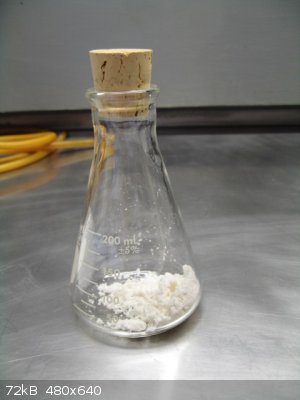
Once the lactam is prepared it is to be extracted with CCl4, which I do not have in sufficient quantity. Therefore I would like to ask the forum
members if anyone has extracted and subsequently crystallized this compound using a different solvent, and what solvent was used. Thanks in advance
for your help.
The single most important condition for a successful synthesis is good mixing - Nicodem
|
|
|
plante1999
International Hazard
    
Posts: 1936
Registered: 27-12-2010
Member Is Offline
Mood: Mad as a hatter
|
|
A short resume of the procedure used could be interesting Magpie, else then that, polymers are just a nice, but unexplored home chemist subject.
|
|
|
UnintentionalChaos
International Hazard
    
Posts: 1454
Registered: 9-12-2006
Location: Mars
Member Is Offline
Mood: Nucleophilic
|
|
There's always an alternative in orgsyn! They use chloroform to extract and vacuum distill to purify. If brewster recrystallizes from tet, I don't see
why chloroform would be a problem. They have similar polarity and boiling points.
http://www.orgsyn.org/Content/pdfs/procedures/cv2p0371.pdf
The 1921 paper in Helvetica Chimica Acta uses ether to extract and a vac distillation.
The 1900 paper (first lit report of prep!) suggests a recrystallization from ether forming "magnificent crystals"
Disclaimer: I am not even somewhat fluent in German, I just did some google translating. I may have missed something.
[Edited on 10-6-14 by UnintentionalChaos]
Attachment: phplpS7l3.pdf (555kB)
This file has been downloaded 471 times
Attachment: phpOdMhlS.pdf (1.4MB)
This file has been downloaded 544 times
Department of Redundancy Department - Now with paperwork!
'In organic synthesis, we call decomposition products "crap", however this is not a IUPAC approved nomenclature.' -Nicodem
|
|
|
Chemosynthesis
International Hazard
    
Posts: 1071
Registered: 26-9-2013
Member Is Offline
Mood: No Mood
|
|
Toluene is mentioned in many patents including US4148793.
Are you going to use oleum for your next step?
|
|
|
Magpie
lab constructor
    
Posts: 5939
Registered: 1-11-2003
Location: USA
Member Is Offline
Mood: Chemistry: the subtle science.
|
|
Quote: Originally posted by plante1999  | | A short resume of the procedure used could be interesting Magpie, else then that, polymers are just a nice, but unexplored home chemist subject.
|
The procedure used to make the oxime is extremely simple, requiring only a 50 mL Erlenmeyer flask. I used cyclohexanone recovered from PVC pipe
cement, photography grade hydroxylamine HCl, and Ebay NaOAc sold for hot ice sculptures. The NaOAc serves as a buffer to hold the pH in the 4-5
region. Mix these reagents, cork, and shake for 3 minutes - that's all there is to it! Capture the crystals on a Buchner funnel. I washed them
carefully twice with cold water as my cyclohexanone was old and yellowish. The melting point was 88-89°C compared to Brewster's value of 89-90°C.
Yield was 57%.
Yes, I did check OrgSyn to see what they might have used but must have missed what you found UC. Thank you.
I do have chloroform and benzene and thought that either of these would likely be suitable. I prefer not to mess with ether if I can avoid it. Pet
ether, which I also have, is used to crash the crystals out of the CCl4 in Brewster.
My procedure calls for 85% H2SO4 and self-heat to catalyze the Beckmann rearrangement to the lactam.
I should add that Brewster considers the crystallization to be a challenge, with some oil being formed.
[Edited on 6-10-2014 by Magpie]
The single most important condition for a successful synthesis is good mixing - Nicodem
|
|
|
Magpie
lab constructor
    
Posts: 5939
Registered: 1-11-2003
Location: USA
Member Is Offline
Mood: Chemistry: the subtle science.
|
|
I made some more progress on this synthesis today. The cyclohexanone oxime was mixed with 85% H2SO4 to catalyze the rearrangement to ε-caprolactam.
The mix is heated to 120° then the reaction proceeds violently on its own but is over quickly. As Brewster warns make sure the opening of the flask
is not pointed in your direction! There was some charring as indicated by the brown color.
The product was then brought to pH 9 with strong NaOH all-the-while cooling to 5-10°C in an ice-bath. It was necessary to add ~200 mL of water just
to keep the by-product Na2SO4 in solution. It would have been better to use KOH per OrgSyn.
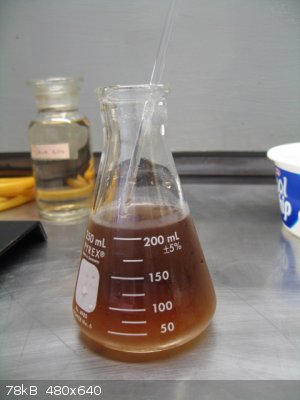
product mix at pH 9
The mix was then extracted with 3x15 mL of chloroform. This produced clean separations.
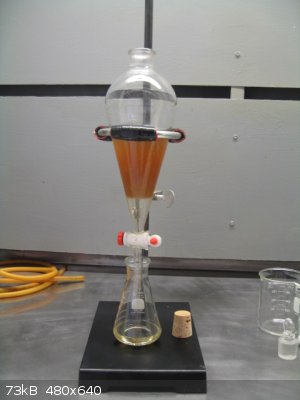
3rd extraction with chloroform
The combined extract is now being dried over anhydrous MgSO4. I will leave it overnight (I'm tired).
[Edited on 8-10-2014 by Magpie]
The single most important condition for a successful synthesis is good mixing - Nicodem
|
|
|
Magpie
lab constructor
    
Posts: 5939
Registered: 1-11-2003
Location: USA
Member Is Offline
Mood: Chemistry: the subtle science.
|
|
Here's the final steps of my synthesis of ε-caprolactam continued from above. The dried chloroform extract was filtered to remove the MgSO4. A
simple distillation was used to remove the chloroform. It came over cleanly at its bp of 63°C, the lactam having a bp of 270.8°C. The lactam oil
left in the pot is shown below.
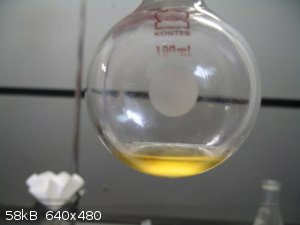
ε-caprolactam oil at room temperature
A known amount of chloroform was then added (~10 mL). Per Brewster (4th ed, not 5th) I then added pet ether in an effort to cause cloudiness. I’d
added about 35 mL before giving up as no cloudiness appeared. Per Brewster I began to evaporate all of the pet ether using a steam bath. I realized
I’d forgotten to add a boiling stone. Then in a classic beginner error (not something an experienced chemist would ever do) I tossed in the stone
before cooling. NO-NO-NO-NO! You guessed it – about 75% of the extract boiled over onto the steam bath and was lost forever. (There was no fire.)
Very pissed I trudged on and boiled down the remaining product to just the oil. A few mLs of pet ether was added. Still no cloudiness. In a last
ditch effort I stuck the solution in the ice bath. A few seconds later I had massive crystallization.The crystals were washed with pet ether, vacuum
filtered, then dried in the sun.
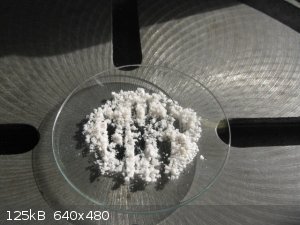
ε-caprolactam crystals
Because of the boilover I won’t be able to calculate a yield. The weight of what I salvaged is 0.5g. Its mp is 67-68°C with the lit value being
69.2°C.
Questions, comments, and suggestions are welcomed.
The single most important condition for a successful synthesis is good mixing - Nicodem
|
|
|
CuReUS
National Hazard
   
Posts: 928
Registered: 9-9-2014
Member Is Offline
Mood: No Mood
|
|
very nice write up ,as always
you could try to heat the caprolactam with a base to get perlon
http://en.wikipedia.org/wiki/Nylon_6
video on perlon -http://www.youtube.com/watch?v=K4EuwOMAlk4
|
|
|
Magpie
lab constructor
    
Posts: 5939
Registered: 1-11-2003
Location: USA
Member Is Offline
Mood: Chemistry: the subtle science.
|
|
Thank you. I thought about that too.
The single most important condition for a successful synthesis is good mixing - Nicodem
|
|
|
CuReUS
National Hazard
   
Posts: 928
Registered: 9-9-2014
Member Is Offline
Mood: No Mood
|
|
magpie ,you could also treat cyclohexanone directly with hydrazoic acid(sodium azide +H2SO4 ) to get caprolactam directly
sodium azide can be extracted from car air bags,there is a thread about that here
the sodium azide is (NaN3 ) is slowly added to the solution of cyclohexanone in sulphuric acid ,which liberates hydrazoic acid ,which
reacts with the ketone to give the lactam
its called the schmidt reaction
http://en.wikipedia.org/wiki/Schmidt_reaction
if excess N3H is used, you will get tetrazoles from ketones
so with cyclohexanone ,you will get cardiazole
|
|
|
Dr.Bob
International Hazard
    
Posts: 2658
Registered: 26-1-2011
Location: USA - NC
Member Is Offline
Mood: No Mood
|
|
Great experiment, other than the lost material, but that happens. If using hydrazoic acid(sodium azide +H2SO4 ), be aware that even slight traces of
this can cause unconsciousness, due to lowered blood pressure. HN3 is a very potent vasodilator. One of my professors nearly killed himself working
with it, even in a hood, as he let the sash open too far.
Also, as I am learning from the news, many air bags now use other chemicals to inflate, including tetrazole, ammonium nitrate, and others, so be
careful mixing with acid until you confirm what the material in the airbag inflator actually is. Over the years I have learned that often things are
not what I thought they were in OTC products.
|
|
|